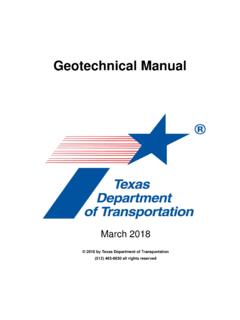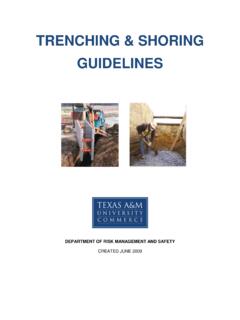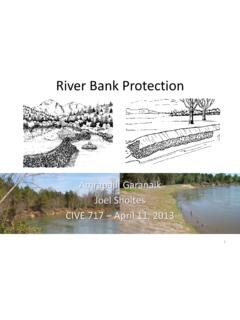Transcription of Construction Specification 495 – Geotextile - USDA
1 Construction Specification 495 Geotextile 1. Scope This work consists of furnishing all material, equipment, and labor necessary for the installation of geotextiles. 2. Quality Fibers (threads and yarns) used in the manufacture of Geotextile shall consist of synthetic polymers composed of a minimum of 85 percent by weight polypropylenes, polyesters, polyamides, polyethylene, polyolefins, or polyvinylidene-chlorides. They shall be formed into a stable network of filaments or yarns retaining dimensional stability relative to each other. The geo-textile shall be free of defects and conform to the physical requirements in Tables 1 and 2. The Geotextile shall be free of any chemical treatment or coating that significantly reduces its porosity. Fibers shall contain stabilizers and/or inhibitors to enhance resistance to ultraviolet light.
2 Thread used for factory or field sewing shall be of contrasting color to the fabric and made of high strength polypropylene, polyester, or polyamide thread. Thread shall be as resistant to ultraviolet light as the Geotextile being sewn. Geotextiles shall be classified based on the method used to place the threads or yarns forming the fabric. The geotextiles will be grouped into woven and nonwoven types. Woven Fabrics formed by the uniform and regular interweaving of the threads or yarns in two directions. Woven fabrics shall be manufactured from monofilament yarn formed into a uniform pattern with distinct and measurable openings, retaining their position relative to each other. The edges of fabric shall be selvedged or otherwise finished to prevent the outer yarn from unraveling. Nonwoven Fabrics formed by a random placement of threads in a mat and bonded by heat-bonding, resin-bonding, or needle punching.
3 Nonwoven fabrics shall be manufactured from individual fibers formed into a random pattern with distinct, but variable small openings, retaining their position relative to each other when bonded by needle punching, heat, or resin bonding. The use of nonwovens other than the needle punched geotextiles is somewhat restricted (see note 3 of Table 2). The Type and Class of Geotextile shall be as shown on the drawings. NRCS MEFOTG Section IV (495-1) June,2004 Table 1 Requirements for woven geotextiles Property Test Method Class I Class II & III Class IV Tensile strength ASTMD4632 200 minimum in any 120 minimum in any 180 minimum (pounds) 1/ grab test principal direction principal direction in any principal direction Elongation at failure ASTMD4632 <50 <50 <50 (percent)
4 1/ grab test Puncture ASTMD4833 90 minimum 60 minimum 60 minimum (pounds) 1/ Ultraviolet light ASTMD4355 70 minimum 70 minimum 70 minimum (% residual tensile 150-hr exposure strength) Apparent opening ASTMD4751 As specified, but As specified, but As specified, but size (AOS) no smaller than no smaller than no smaller than mm(#70) 2/ mm(#70) 2/ mm(#70) 2/ Percent open area CWO-02215-86 minimum minimum minimum (percent) Permitivity sec -1/ ASTMD4491 minimum minimum minimum 1/ Minimum average roll value (weakest principal direction).
5 2/ standard sieve size Note: CWO is a USACE reference Table 2 Requirements for nonwoven geotextiles Property Test Method Class I Class II Class III Class IV 3/ Tensile strength ASTMD 4632 180 minimum 120 minimum 90 minimum 115 minimum (lb) 1/ grab test Elongation at ASTMD 4632 >50 >50 >50 >50 failure (%) 1/ Puncture ASTMD 4833 80 minimum 60 minimum 40 minimum 40 minimum (pounds) Ultraviolet light ASTMD 4355 70 minimum 70 minimum 70 minimum 70 minimum (% residual 150-hr exposure tensile strength) Apparent ASTMD4751 As specified As specified As specified As specified opening max. #40 2/ max. #40 2/ max.
6 #40 2/ max. #40 2/ size (AOS) Permitivity ASTMD4491 minimum minimum minimum minimum sec -1/ 1/ Minimum average roll value (weakest principal direction). 2/ standard sieve size. 3/ Heat-bonded or resin-bonded Geotextile may be used for classes III and IV. They are particularly well suited to class IV. Needle-punched geotextiles are required for all other classes. NRCS MEFOTG Section IV (495-2) June,2004 3. Storage Before use, the Geotextile shall be stored in a clean, dry location out of direct sunlight, not subject to extremes of either hot or cold temperatures, and with the manufacturer s protective cover undisturbed. Receiving, storage, and handling at the job site shall be in accordance with the requirements listed in ASTM D 4873.
7 4. Surface preparation The surface on which the Geotextile is to be placed shall be graded to the neat lines and grades as shown on the drawings. It shall be reasonably smooth and free of loose rock and clods, holes, depressions, projections, muddy conditions, and standing or flowing water (unless otherwise specified in drawings). 5. Placement Before the Geotextile is placed, the soil surface will be reviewed for quality assurance of the design and Construction . The Geotextile shall be placed on the approved prepared surface at the locations and in accordance with the details shown on the drawings. It shall be unrolled along the placement area and loosely laid, without stretching, in such a manner that it conforms to the surface irregularities when material or gabions are placed on or against it. The Geotextile may be folded and overlapped to permit proper placement in designated area(s).
8 Method 1 The Geotextile shall be joined by machine sewing using thread material meeting the chemical requirements for the Geotextile fibers or yarn. The sewn overlap shall be 6 inches, and the sewing shall consist of two parallel stitched rows at a spacing of about 1 inch and shall not cross (except for any required re-stitching). The stitching shall be a lock-type stitch. Each row of stitching shall be located a minimum of 2 inches from the Geotextile edge. The seam type and sewing machine to be used shall produce a seam strength, in the specified Geotextile , that provides a minimum of 90 percent of the tensile strength in the weakest principal direction of the Geotextile being used, when tested in accordance with ASTM D 4884. The seams may be factory or field sewn. The Geotextile shall be temporarily secured during placement of overlying material to prevent slippage, folding, wrinkling, or other displacement of the Geotextile .
9 Unless otherwise specified, methods of securing shall not cause punctures, tears, or other openings to be formed in the Geotextile . Method 2 The Geotextile shall be joined by overlapping a minimum of 18 inches (unless otherwise specified) and secured against the underlying foundation material. Securing pins, approved and provided by the Geotextile manufacturer, shall be placed along the edge of the panel or roll material to adequately hold it in place during installation. Pins shall be steel or fiberglass formed as a U, L, or T shape or contain ears to prevent total penetration through the Geotextile . Steel washers shall be provided on all but the U-shaped pins. The upstream or upslope Geotextile shall overlap the abutting downslope Geotextile . At vertical laps, securing pins shall be inserted through the bottom layers along a line through approximately the mid-point of the overlap.
10 At horizontal laps and across slope labs, securing shall be inserted through the bottom layer only. Securing pins shall be placed along a line about 2 inches in from the edge of the placed Geotextile at intervals not to exceed 12 feet unless otherwise specified. Additional pins shall be installed as necessary and where appropriate to prevent any undue NRCS MEFOTG Section IV (495-3) June,2004 slippage or movement of the Geotextile . The use of securing pins will be held to the minimum necessary. Pins are to remain in place unless otherwise specified. Should the Geotextile be torn or punctured, or the overlaps or sewn joint disturbed, as evidenced by visible Geotextile damage, subgrade pumping, intrusion, or grade distortion, the backfill around the damaged or displaced area shall be removed and restored to the original approved condition.















